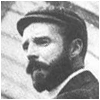26/5/1874 - 17/7/1958
Record updated 24-May-06

Henri Farman was born in Paris of English parents on May 26, 1874. Although educated at the Paris School of Fine Arts as a painter.
Farman had a natural flair for getting the 'feel' of a piece of machinery, and enjoyed considerable success. In the 1890s he became a championship cyclist, and at the turn of the century he discovered motor racing.
In 1900 the Paris-Vienna race was combined with the Gordon Bennett Cup. The Gordon Bennett cars running only from Paris-Innsbruck and the rest of the entry going on to Vienna. Marcel Renault was the first man to make it to Vienna, 12 minutes ahead of Henri Farman's Panhard
He came fifth in the Paris-Berlin road race of 1901, and then won the Paris-Vienna in 1902. With his mechanic he covered the 615 miles to the Austrian capital in just 16 hours.
In 1903 he came in third in that year's Gordon Bennett Race, which was held in Ireland after the French government banned racing on open roads as too dangerous. Farman himself became a casualty of the sport when he was involved in a serious accident. He fully recovered, but the experience destroyed his enthusiasm for cars. Nevertheless his fascination with technology endured.
With his brother, Maurice, Henri learned to fly in a Voisin and shortly thereafter, in 1907, ordered his own aircraft incorporating his design modifications of a dihedral in the wings and the reduction of the tail to a single plane. These intuitive rather than scientific modifications were the first steps in a long career in which Henri Farman diagnosed and solved a myriad of aircraft control and structural problems.
On January 13, 1908, in his modified craft, Henri Farman won the prestigious Archdeacon prize by demonstrating his ability to fly a circuit of one kilometer, even with lateral control problems. In 1908, the incorporation of the first efficient ailerons provided the solution to this enormously difficult and dangerous problem.
In 1909, Henri Farman began one of the first formal, flight training schools and in 1914 founded the Farman Aviation Works that produced more than twelve thousand military aircraft for France in World War I.
In succeeding years the brothers Henri and Maurice, now joined by Dick, enjoyed both financial and technical success with a series of advanced designs, including the twin-engined Goliath capable of carrying twelve passengers. With this aircraft, they established their airline, Farman Lines, which was a forerunner of Air France.
Henri Farman was at the forefront of European aviation development from its infancy to maturity. His analytical skills, piloting ability and uncommon business acumen, contributed to France's major role in world aviation until his death in 1958.